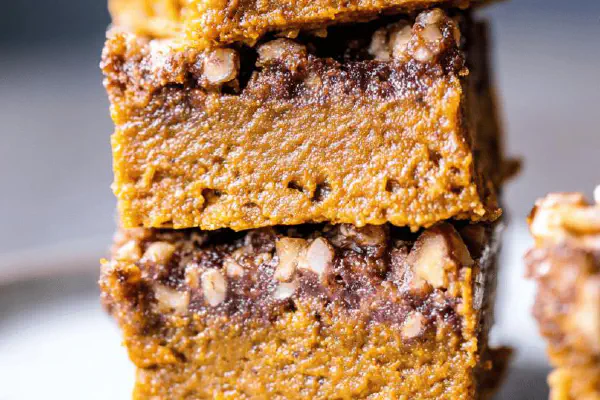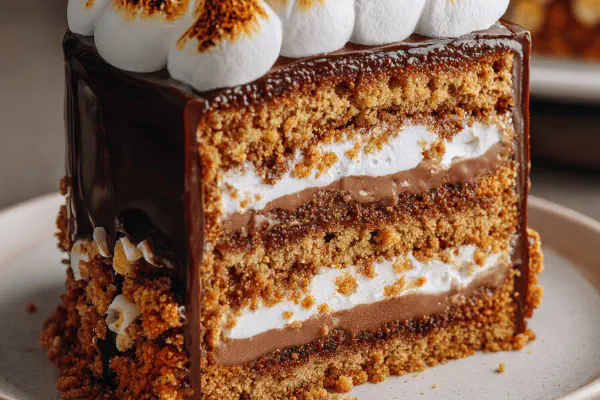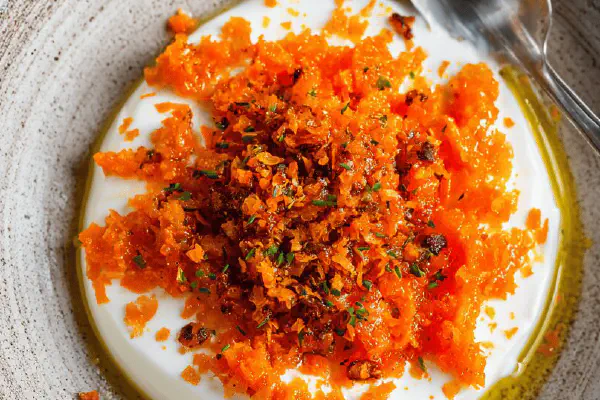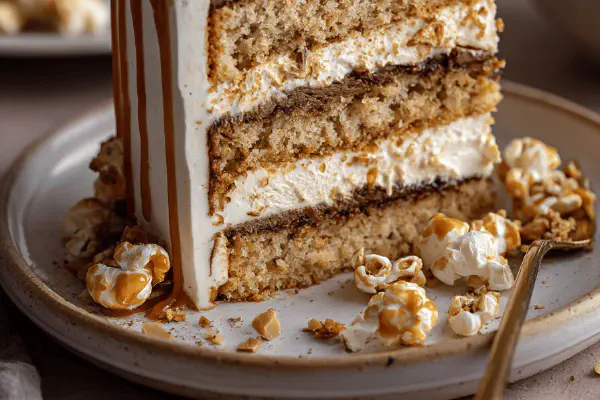Pumpkin Spice Cake with Dark Ganache
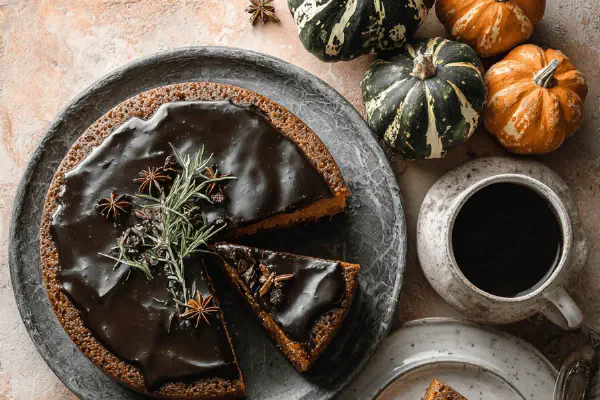
By Emma
Certified Culinary Professional
Ingredients
- 1 kabocha squash about 1 kg cut in chunks
- 200 g all-purpose flour (1 1/2 cups)
- 65 g whole wheat pastry flour (1/2 cup packed)
- 5 ml baking powder (1 tsp)
- 2.5 ml baking soda (1/2 tsp)
- 1 ml ground ginger (1/4 tsp)
- 1 ml star anise ground (1/4 tsp)
- 1 ml fennel powder (1/4 tsp)
- pinch black pepper
- 170 g unsalted butter softened
- 260 g dark brown sugar (1 1/4 cups packed)
- 3 large eggs
= Ganache =
- 400 g bittersweet chocolate chopped
- 430 ml coconut cream full fat
About the ingredients
Method
Cake
- Preheat oven to 175 C (350 F). Rack in middle. Lining baking sheet with silicone mat or parchment. Butter sides of two 20cm (8 in) springform pans, bottoms lined with parchment.
- Roast squash chunks on baking sheet. Check after 40 minutes. Stir once or twice. Squash should be tender, tiny crackling audible as edges caramelize. Times vary with oven quirks.
- Puree squash in food processor until velvety but not watery. Cool to near room temp. Need about 1 1/2 cups (375 ml) puree. If dry, add a splash of milk or cream.
- Sift together flours, baking powder, soda, spices, pepper. Smells earthy and spicy combined. Set aside.
- Beat butter with dark brown sugar until creamy, lighter in color, using electric mixer. Patience here, crucial for good crumb. Add eggs one by one, fully incorporated each time. Then fold in squash puree gently but well mixed.
- Add dry ingredients gradually. Avoid overmixing; batter should be thick but pourable and spread easily. Scrape bowl cuts sides to mix evenly.
- Divide batter evenly in pans. Smooth tops with spatula. A little shimmy to settle the batter and remove air pockets.
- Bake about 30-35 minutes. Don’t rely blind on time. Cake edges lift, center set but still moist. Insert toothpick should come out with few crumbs. Remove from oven promptly to avoid dryness.
- Cool in pans 15 minutes before loosening sides. Remove cakes, invert onto wire rack. Cool completely, about 2 hours, before layering.
Ganache
- Place chopped bittersweet chocolate in bowl.
- Bring coconut cream to near boil over low heat; watch carefully to avoid scorching or skin forming. Pour hot cream over chocolate, rest 3 minutes.
- Whisk gently until glossy and smooth. No lumps, no streaks. Let cool at room temp until thick but spreadable, roughly 2-3 hours. Stir occasionally to check consistency.
- If ganache thickens too long or hardens in fridge, warm gently over double boiler to soften before using.
Assembly
- Slice each cake horizontally into two even layers. Use serrated knife and saw gently to avoid crumbs flying everywhere.
- Place one layer on serving plate. Spread generous amount of ganache evenly. Repeat two more times. Top layer left plain to seal in moisture but brush with thin ganache layer.
- Use remaining ganache to coat sides. Use offset spatula for smooth finish or rustic swirls. Chill briefly if spreading gets messy.
- Let cake rest at room temp 30 minutes for ganache to set properly.
- Serve with powdered sugar dust or toasted pepitas for texture and punch contrast.
= Tips and Troubleshooting =
- If kabocha unavailable, use butternut or buttercup squash—the dryness varies but puree similarly. Add moisture cautiously.
- Whole wheat pastry flour boosts flavor and crumb heft but if you want softer, swap fully for all-purpose flour.
- Coconut cream gives ganache subtle sweetness and silkier texture than dairy cream. Use canned, chill well beforehand. In hurry, heavy cream works as classic substitute.
- Watch closely when roasting squash; caramelized edges bring depth but burnt spots show neglect.
- Don’t rush cooling cake layers or ganache; unstable layers twist or crumble when warm.
- If baking pan bottom sticks, grease well and sharp knife to loosen edges after baking. Paper underneath always helps.
- Dark brown sugar adds molasses notes and moisture better than light sugar.
- Eggs room temp, butter softened, all crucial for proper batter mixing and rise.
- A pinch of black pepper highlights spice blend subtly; don’t omit unless sensitive or kids eating.
- Storage: Cake stays moist covered up to 3 days. Ganache firms up in fridge; bring to room temp before slicing.
Cooking tips
Chef's notes
- 💡 Roast squash chunks uniform size on parchment or silicone mat. Stir once or twice, watch for caramelized edges and crackling sound. That dry sizzle means sugars browning—not burnt but close. Avoid soggy puree by not oversteaming; dry flesh means thicker batter and less weep.
- 💡 Beat butter and dark brown sugar slow, electric mixer best. Whip until lighter in color, creamy texture before adding eggs one at a time. Eggs room temp easy to incorporate, boosts volume and keeps crumb tender. Don’t rush batter mixing or dense cake follows.
- 💡 Fold dry ingredients gently. Avoid overmixing or gluten tightens, cake tough. Batter should be thick yet pourable, not runny. Scrape bowl sides often. Texture like soft fudge batter, not pancake thin. Add splash milk to squash puree if too dry but cautiously, extra moisture hurts structure.
- 💡 Temperature key for ganache. Coconut cream near boiling then poured hot over chopped chocolate. Rest 3 minutes before whisking smooth and glossy. Let cool at room temp until spreadable fudge consistency, 2-3 hours usually. Too cold thickens too hard; too warm runs off layers.
- 💡 Cake layering needs cool, fully set ganache or it breaks and slides. Slice horizontally with serrated knife slow saw motion. Use offset spatula for ganache spread sides with rustic swirls. Rest assembled cake 30+ minutes at room temp before slicing. Patience prevents disastrous crumb fallout.
Common questions
Kabocha unavailable what?
Use butternut or buttercup squash. Texture slightly wetter; puree carefully. Adjust moisture. Watch for less caramelization, roasting longer may help. Flavor milder but works. Whole wheat flour still works fine, though crumb changes slightly.
Ganache too thick or hard?
Warm gently over double boiler or short microwave burst. Stir slowly to soften. Avoid overheating or grainy texture. Using canned coconut cream chilled well helps texture consistency. Heavy cream substitute fine for faster set but flavor changes.
Cake gets dry sometimes why?
Overbake main issue. Watch edges lift, center just set moist. Toothpick has few moist crumbs. Cooling in pans 15 minutes helps hold moisture. Slice after full cooling or fragile crumb. Avoid opening oven often early; oven quirks affect bake time.
How store leftovers best?
Cover loosely room temp cake stays moist 2-3 days. Ganache firms fridge quickly; bring to room temp before slicing to avoid crumb tear. Can refrigerate but cake texture changes. Use parchment or loosely covered container to avoid dryness or off flavors.
